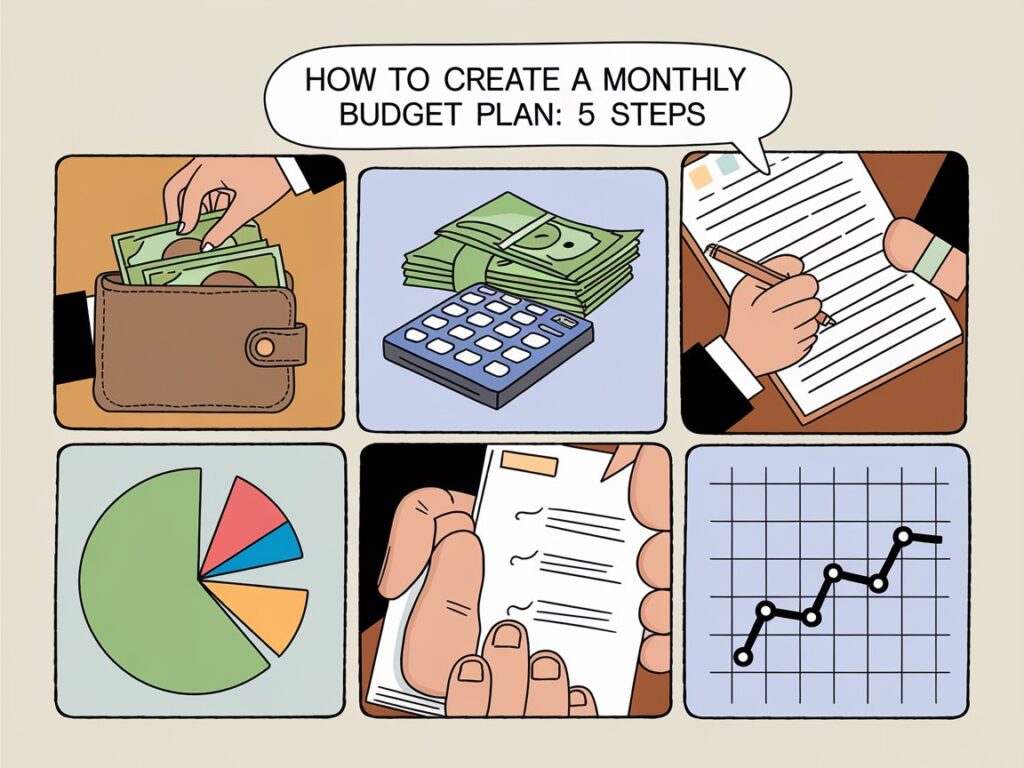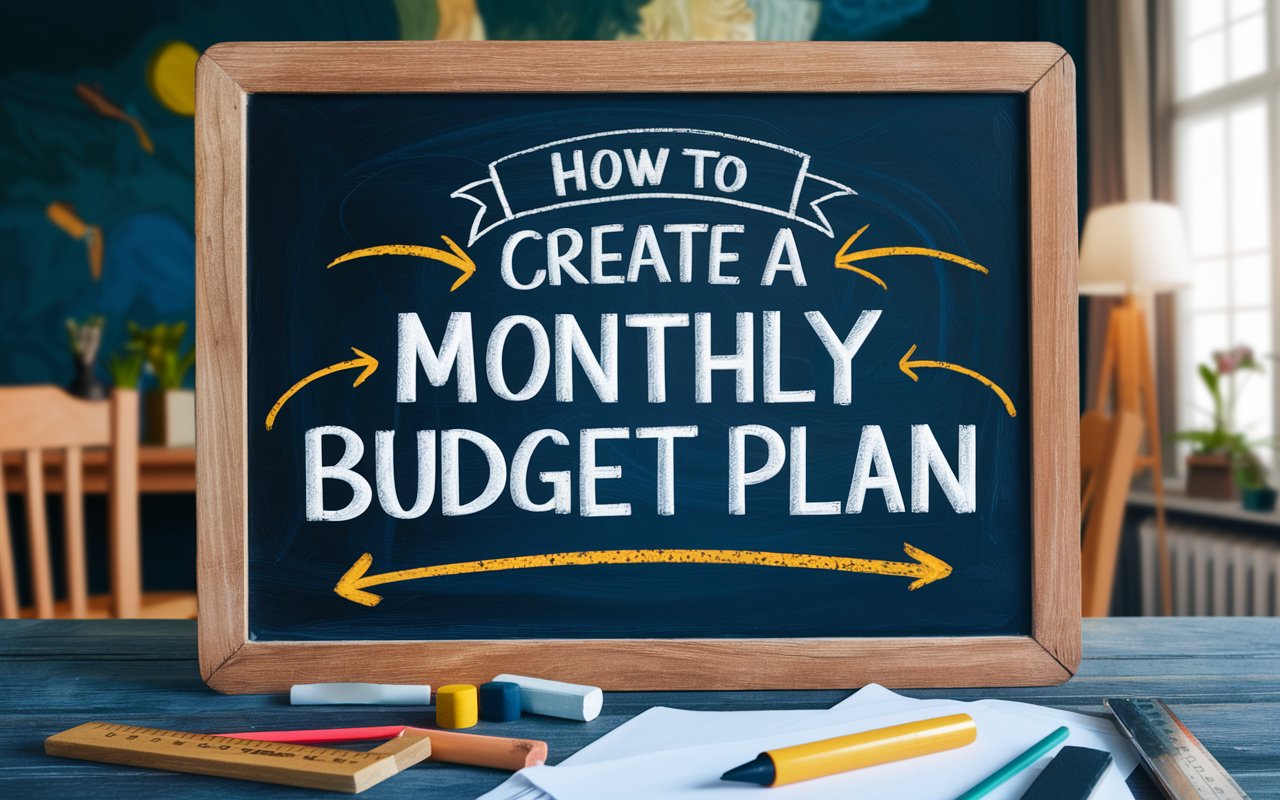Budgeting can be a powerful tool for managing your money and reaching your financial goals.
When I first started budgeting, I was surprised by how much I learned about my spending habits.
Let’s dive into the basics of creating a monthly budget that truly works for you.
What is a Monthly Budget?
A monthly budget is a simple plan. It tracks your income and outlines where it goes.
The idea is to balance your income with your expenses, so you avoid debt and save more.
This approach helps you see how you’re managing money each month..
Setting up a budget plan is like creating a map. It shows your financial path and helps you avoid surprises.
Instead of wondering where your money went, you know exactly what you have and what you need.
A monthly budget plan lets you see patterns in your spending.
You’ll know how much you spend on basics like rent, food, and utilities.
With this information, you’ll make better choices about where your money goes.
The goal is not just to spend less but to make choices that match your priorities.
Why Budgeting is Important
Budgeting matters because it keeps your finances in check.
It gives you control over where your money goes and helps prevent unexpected financial stress.
With a monthly budget plan, you can see your cash flow and how your expenses stack up against your income.
Having a budget also helps you avoid debt. When you set limits for each category, you’re less likely to overspend.
Instead, you focus on staying within your limits and possibly finding ways to save more.
If you’re saving for something big like a car, home, or vacation, a budget plan keeps you on track.
Additionally, budgeting is crucial for building an emergency fund.
Life can throw surprises, and having funds set aside gives peace of mind.
Knowing you have a cushion for emergencies makes managing monthly expenses much easier.
Key Statistics on Spending and Savings
Understanding the numbers around budgeting helps give context. Let’s look at real-time data on average monthly spending in the U.S.:
| Expense Category | Average Monthly Cost |
| Housing | $1,674 |
| Transportation | $813 |
| Food | $610 |
| Personal Insurance | $590 |
| Healthcare | $398 |
| Entertainment | $243 |
| Miscellaneous | $158 |
With these figures, you can compare and adjust your spending.
Using real data helps us understand where most Americans spend and shows where we might cut back.
Tracking these numbers also allows us to set reasonable goals for savings and spending.
Savings statistics show that less than half of Americans have an emergency fund that would cover three months of expenses.
For some, budgeting is a step toward reversing this trend.
Understanding how much people save can inspire you to set higher savings goals within your monthly budget.

How to Create a Monthly Budget Plan: 5 Steps
Creating a budget involves a few important steps. Follow these steps for a plan that fits your life.
1. Calculate Your Monthly Income
The first step in budgeting is knowing how much money you make.
Calculate your monthly income by adding up all sources, such as salary, side jobs, or freelance work.
If your income varies, estimate a low average to be safe.
After calculating income, record it in a budget planner or spreadsheet.
This step gives you a base number to work with.
Think of it as the start of your budgeting journey.
When you know your total income, you’ll be able to create accurate spending and saving goals.
2. Track Your Spending for a Month or Two
Tracking your expenses helps you see exactly where your money goes. Record every cost, even the small ones.
You can use apps, spreadsheets, or notebooks to log your spending. Seeing it all in one place may surprise you!
Break down your spending into categories like food, rent, utilities, and entertainment. The goal here is to identify areas where you might overspend.
Tracking expenses for a few months also shows spending patterns, so you’ll know where to adjust if needed.
Creating a monthly savings plan becomes easier when you know where to cut back.
Perhaps you’re spending more than you realize on takeout or streaming services.
Awareness allows you to make changes, like cooking at home more often or trimming subscriptions.
3. Think About Your Financial Priorities
Now, think about your financial priorities.
Do you want to save for a home, pay off debt, or build an emergency fund.
Defining priorities keeps your budget aligned with your life goals.
.List your top priorities and rank them by importance.
Are you focused on paying off debt, saving for retirement, or building a vacation fund.
Knowing your goals helps you allocate funds in a way that reflects your values.
.Financial priorities also help when adjusting your budget.
For instance, if you value travel but need to save, you might allocate less to entertainment and more to a travel fund.
Your budget should support what matters most to you, creating a sense of satisfaction each month.
4. Design Your Budget
Designing a budget means setting limits on each expense category.
Start by listing your necessary expenses. Common budget categories include rent, utilities, and groceries.
After essential expenses, set limits for extras like dining, hobbies, and shopping.
Here’s an example of how you might organize your expenses:
| Category | Budget Amount |
| Rent or Mortgage | $1,200 |
| Utilities | $200 |
| Food | $400 |
| Transportation | $150 |
| Insurance | $100 |
| Entertainment | $100 |
| Savings | $300 |
Making a budget planner helps keep spending in check.
Seeing everything in a table format clarifies where cuts may be needed.
Keep categories clear, and adjust them as needed to fit your goals.
For example, if you want to save more, consider cutting back on entertainment or dining out.
Common Expense Categories in a Budget:
- Rent or mortgage payment
- Property taxes
- Car payment and gasoline
- Food and groceries
- Utilities and insurance
- Childcare and medical bills
- Tuition fees and maintenance
- Gym membership and travel expenses
Listing out each of these items makes it easier to see how each affects your overall monthly budget. As you create categories, consider what you can adjust to meet your goals.
5. Track Your Spending and Refine Your Budget as Needed
Budgeting doesn’t stop once it’s set up.
Tracking your spending each month ensures you’re sticking to the plan.
Adjust categories as needed if you find you’re overspending or underspending.
Reviewing your monthly budget lets you catch areas that need refining.
Perhaps you’re often spending too much on groceries or not enough on entertainment.
Regularly updating your budget keeps it relevant to your life.
After tracking for a few months, your budget becomes more accurate.
Adjust spending limits to stay on track with your income-based budgeting.
Each month is a chance to fine-tune and improve, so your budget works even better for you.

Monthly Budget Example
Creating a sample budget can help you visualize how your income is allocated. Below is an example that might help:
| Expense Category | Monthly Budget | Actual Spending |
| Housing | $1,200 | $1,150 |
| Utilities | $200 | $180 |
| Groceries | $400 | $450 |
| Transportation | $150 | $130 |
| Insurance | $100 | $100 |
| Entertainment | $100 | $75 |
| Savings | $300 | $350 |
Seeing a sample like this shows where adjustments are needed. In this case, extra grocery expenses might need cutting.
The monthly savings plan increased, showing extra funds went into savings.
Budgeting Resources
There are plenty of tools and resources that make budgeting simpler.
Apps like Mint, YNAB (You Need a Budget), and PocketGuard provide easy tracking and reminders.
Each tool has features for creating and adjusting a budget without hassle.
Budget planner printables are another helpful option.
These sheets let you plan and track expenses manually, which works well for visual learners.
Many websites offer free templates that you can customize to fit your budget needs.
Books like The Total Money Makeover by Dave Ramsey also provide great insights.
Ramsey focuses on budgeting basics and has a step-by-step method for getting out of debt.
These resources are useful for anyone serious about improving their finances.
Watch this video for more details:
FAQs About Monthly Budget Plan
Key Takeaways
- Budgeting is essential to control spending, manage debt, and achieve financial goals.
- Tracking expenses helps you understand spending habits and find areas to save.
- Setting financial priorities ensures that you’re putting money toward what matters most.
- Adjusting your budget regularly keeps it realistic and aligned with your needs.
- Using a budget plan gives you a clear path to build savings and avoid financial stress.
Creating a monthly budget plan doesn’t have to be overwhelming.
By following a few simple steps and staying consistent, you’ll find that managing money becomes easier.
A well-planned budget gives you control over your finances, helping you avoid debt and achieve goals.
As you get used to budgeting, you’ll see the benefits firsthand.
Whether you’re saving for something big, paying off debt, or just aiming for financial peace, a budget is the foundation.
Start small, track your spending, and adjust as needed.
Before you know it, your budget will be a powerful tool guiding you toward financial security and success. Happy budgeting! 😊




